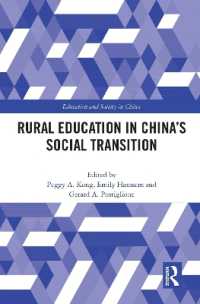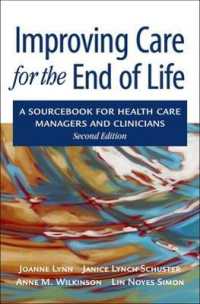- ホーム
- > 洋書
- > 英文書
- > Science / Mathematics
Full Description
Rice is a unique and highly significant crop, thought to help feed nearly half the planet on a daily basis. An understanding of its properties and their significance is essential for the provision of high quality products. This is all the more true today as international trade in rice trade has been increasing rapidly in recent years. This important book reviews variability in rice characteristics and their effects on rice quality.After an introduction on rice quality that also explores paradoxes associated with the crop, the book goes on to examine rice physical properties and milling quality. This leads to a discussion of the effects that the degree of milling has on rice quality. The ageing of rice and its cooking and eating quality are investigated in the following chapters before an analysis of the effect of parboiling on rice quality. Later chapters consider the product-making and nutritional quality of rice and investigate speciality rices and rice breeding for desirable quality. The book concludes with an extensive chapter on rice quality analysis and an appendix containing selected rice quality test procedures.With its distinguished author Rice quality: a guide to rice properties and analysis proves an invaluable resource for professionals in the rice industry and researchers and post-graduate students interested in rice.
Contents
Author contact detailsWoodhead Publishing Series in Food Science, Technology and NutritionPrefaceAcknowledgementsDedicationChapter 1: An introduction to rice: its qualities and mysteriesAbstract:1.1 Rice in history1.2 More rice paradoxes1.3 Rice data and the tales they tell1.4 Rice qualityChapter 2: Physical properties of riceAbstract:2.1 Introduction2.2 Grain appearance2.3 Density and friction2.4 Effect of moisture content2.5 Miscellaneous properties2.6 Chalky grainsChapter 3: Milling quality of riceAbstract:3.1 Milling of rice3.2 Grain cracking or fissuring at or around harvest3.3 Drying of rice3.4 Why the rice grain fissures3.5 Miscellaneous factors that affect milling quality of rice3.6 Fundamental cause of rice breakage: interrelationship and synergy between different factorsChapter 4: Degree of milling (DM) of rice and its effectAbstract:4.1 Milling paddy grain and how much to mill4.2 Effect of degree of milling (DM) on rice qualityChapter 5: Ageing of riceAbstract:5.1 Introduction5.2 Consumers' perception of changes in rice behaviour during storage5.3 Changes in physicochemical properties of rice during ageing as measured in the laboratory5.4 Theories of rice ageing: relation to individual constituents5.5 Some final rice paradoxes5.6 Can the ageing process be hastened or retarded?Chapter 6: Cooking quality of riceAbstract:6.1 Introduction6.2 Absorption of water by rice during cooking at or near the boiling temperature6.3 Hydration at lower temperatures6.4 Loss of solids during cooking6.5 Effect of presoaking in ambient water on cooking6.6 Other changes/events occurring during cooking6.7 Laboratory cooking of rice for various testsChapter 7: Eating quality of riceAbstract:7.1 Introduction7.2 The initiation: the water-uptake paradigm7.3 The period of data accumulation: the amylose paradigm7.4 Exploration at the molecular level: the amylopectin paradigm7.5 Rheology of rice-flour paste7.6 Other factors that effect the eating quality of rice7.7 Testing for rice qualityChapter 8: Effect of parboiling on rice qualityAbstract:8.1 Introduction: parboiled rice8.2 Changes brought about in the rice grain and its constituents during the parboiling process8.3 Properties of parboiled rice8.4 Effect of rice variety on properties of parboiled rice8.5 Products from parboiled riceChapter 9: Product-making quality of riceAbstract:9.1 Introduction9.2 Table rice9.3 Rice flour and products thereof9.4 Rice breakfast cereals and snacks made from wholegrain rice9.5 Other rice productsChapter 10: Speciality ricesAbstract:10.1 Introduction10.2 Aromatic rices10.3 Basmati10.4 Jasmine10.5 Other speciality ricesChapter 11: Nutritional quality of riceAbstract:11.1 Introduction: why do we have to eat?11.2 Nutritive value of rice is not a small matter11.3 The perspective of nutrition of the poor rice-eater11.4 Wholegrains versus refined grains: two views11.5 No, wholegrains confer untold benefits11.6 The perspective of the nutritive value of individual rice constituents11.7 Biotechnological approach to upgrade the nutritive value of riceChapter 12: Rice breeding for desirable qualityAbstract:12.1 Introduction12.2 Plant characteristics for optimum harvest12.3 Physical and morphological properties of the paddy grain that affect the quality of the final product12.4 Susceptibility of the rice grain to cracking12.5 End-use quality12.6 ConclusionsChapter 13: Analysis of rice qualityAppendix: some selected rice quality test proceduresIndex








